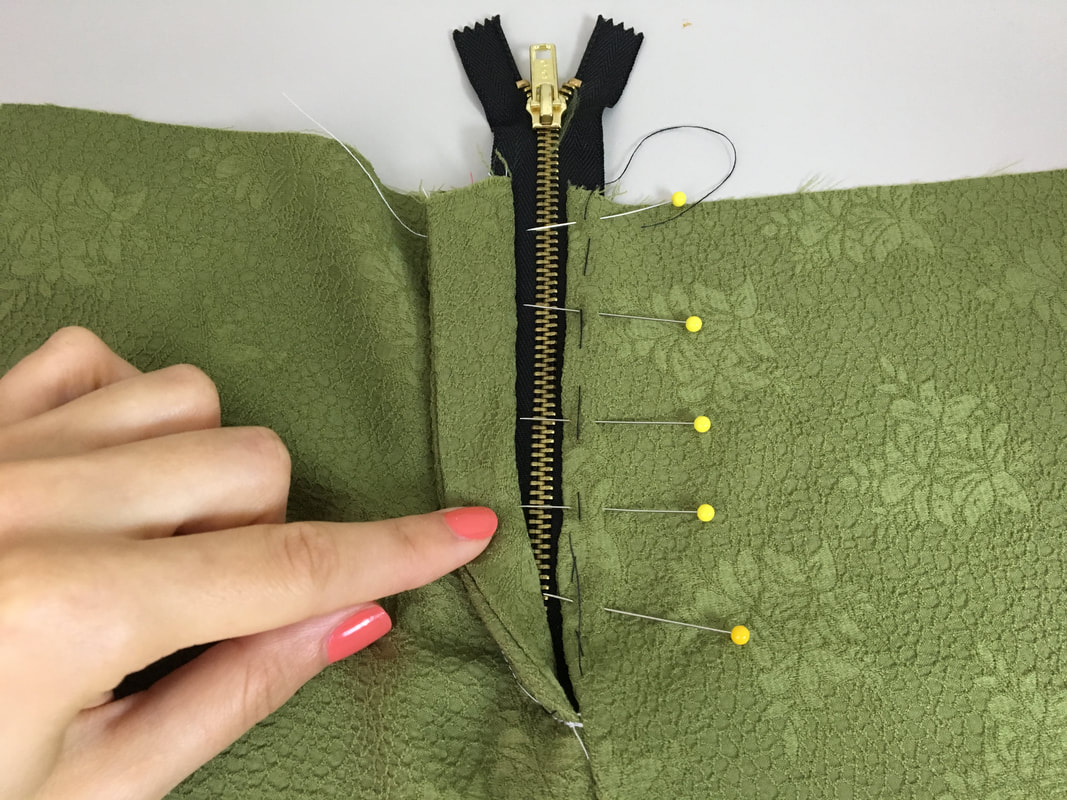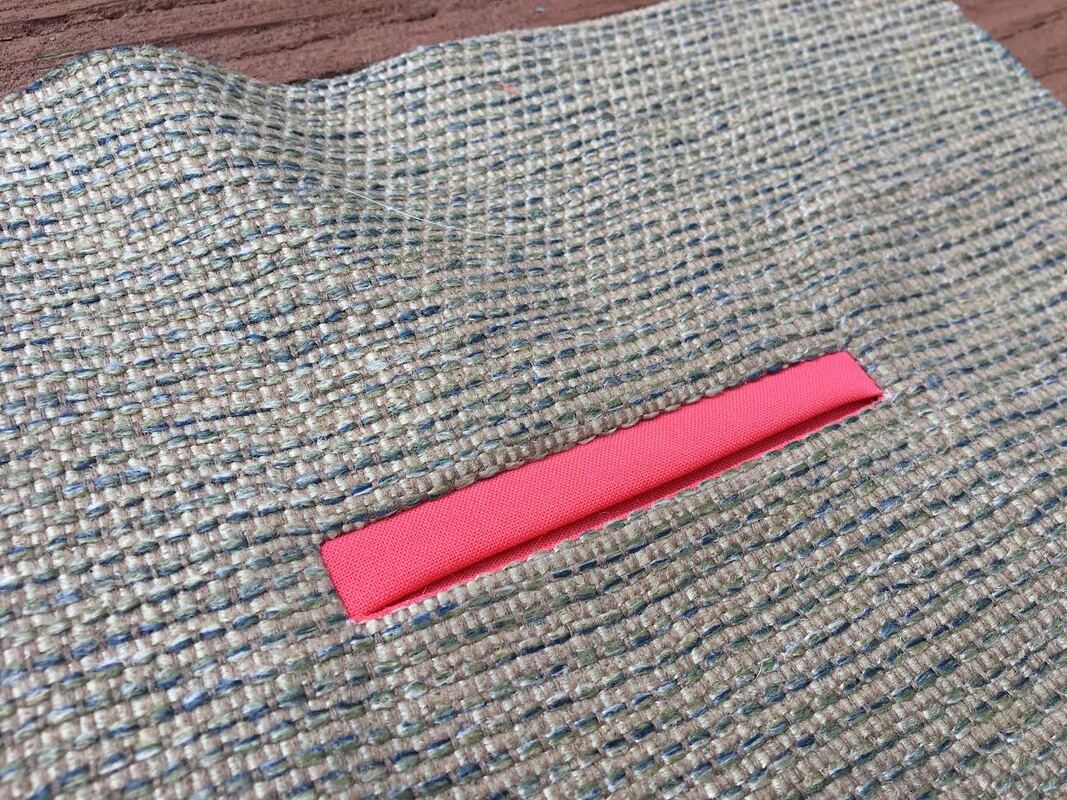|
I've been wanting to write this little tutorial for a little while now. I'm not exactly sure if it was my fear of sewing a fly front zipper or never quite finding the time, but it has been put on the back burner for about a year now. Now that I'm finally getting down to it, I'm feeling pretty inspired. It is true, all zippers can feel a bit intimidating. However, a fly front style in particular is its own spices, or shall I say, beast. I was forced into sewing one recently when I created some custom outfits for two (super talented) musicians (I'll show you more later!). This particular fly front zipper belonged to a pair of jean-like mens trousers. Needless to say, it had to look the part and function by the book. In the steps below, I'll show you the steps for sewing this exact zipper, including an intro to the pattern pieces you need and how to put it all together. Although the zipper in this tutorial is sewn into a pair of pants, an identical process will work for sewing one to a skirt, given that there is a seam able to house it, of course. What is a fly front zipper? As the name suggests, this style is sewn to the fly of women's or menswear trousers (although conventionally used for almost all men's bottoms). There is a directional rule to differentiate between womens wear and menswear: In women's clothing, the fly placket is positioned right over left while in men's clothing it is left over right (shown in this tutorial).
4 Comments
I've had a personal obsession with pockets for years. I love them all regardless of style and find them to be one of the primary functional elements in a garment. Today, I'll show you how to sew one of my all time favorites: the welt pocket. A classic, tailored pocket that is conventionally used with men's trousers, suit jackets, vests and other menswear and womenswear tailored items. Although they seem to be more prevalent in menswear, I love seeing a welt pocket as a design element in more casual women's wear. The clean, high quality finish of a welt pocket can elevate a garment's look and function regardless of whether this a business-appropriate style or a pair of casual shorts. There are two main types of welt pockets: single and double welt, although these derive other styles. Naturally, the single welt pocket has a single welt (rectangular tab) while the double has two, usually equal width taps or welts. As you might have already guessed, the single welt is easier to sew simply for the fact that there is less stitching and measuring involved in comparison to a double style. I do have to admit that welt pockets can be a bit tricky for sewing beginners, but after you sew a few of them, they will definitely start looking more uniform and professional! So if you love welt pockets as much as I do, don't give up on the first try! I recommend that you don't move on to the double welt pocket until you feel comfortable with sewing a single welt. OK, before we move on to the sewing steps below, here are a few things to keep in mind with regards to the construction and styling of welt pockets:
|
The Blog:A journey into our design process, sewing tutorials, fashion tips, and all the inspiring people and things we love. Doina AlexeiDesigner by trade and dressmaker at heart. I spend most of my days obsessing over new fabrics and daydreaming new ideas. Sadie
Executive Assistant & Client Relations Manager Archives
November 2019
Categories
All
|
-
Sewing Tutorials
-
Basics
>
- Aligning Pattern Grainlines To Fabric
- Preparing Fabrics For Sewing
- Pinning Sewing Patterns To Fabric
- Placing Sewing Patterns On Fabric For Cutting
- Rotary Cutters or Fabric Scissors?
- Cutting The Sewing Patterns
- What Are Notches And How To Use Them In The Sewing Process
- Transferring Notches From Pattern To Fabric
- Transferring Seamlines to Fabric
- Staystitching
- Backstitching: A Complete Guide
- Hand Basting: A Complete Guide
- Sewing Continuous Bias Binding
- Darts >
-
Sewing Seams
>
- The Basics Of Seams And Seam Allowance
- How To Sew A Straight Seam
- Sewing Curved Seams
- Sewing Corner Seams
- Trimming And Grading Seam Excess
- Notching/Clipping Seam Allowance for Tension Release
- Sewing Topstitched Seams
- Sewing Corded Seams
- Sewing A Slot Seam
- Sewing A Gathered Seam
- Sewing Bias Seams
- Sewing Seams With Ease
- Sewing Seams With Crossing Seamlines
- Sewing Unlike Fabric Seams
- How To Iron Seams: Ironing Tools And Conventions
- Sewing With Knit Fabrics
- Understanding Stitch Length And Tension
- Sewing Unique Fabric Seams
-
Seam Finishes
>
- Seam Finishing Techniques - Overview
- Applying A Pinked Seam Finish
- Applying A Bias Bound Seam Finish
- Serging And Zigzag Seam Finishes
- Sewing A Self-Bound Seam Finish
- Sewing A French Seam Finish
- Sewing A Hong Kong Seam Finish
- Sewing A Mock French Seam Finish
- Sewing A Turned-and-Stitched Seam Finish
- Sewing Overcast Hand-Applied Seam Finishes
- Sewing A Flat Felled Seam
- Sewing A Hairline Seam Finish
-
Hem Finishes
>
- Garment Hem Finishes: Overview
- Sewing A Double Fold Hem Finish
- Sewing A Single Fold Hem Finish
- Sewing Bound Hem Finishes
- Sewing An Exposed Double Layer Bound Hem
- Sewing A Folded-Up Bound Hem with Pre-folded Binding
- Sewing A Hong Kong Hem Finish
- Sewing A Band Hem Finish
- Sewing A Bias Faced Hem Finish
- Sewing A Twill Tape Hem Finish
- Sewing A Rolled Hem Finish
- Sewing A Shaped Hem Facing
- Using Fusible Hem Tape And Webbing
- Finishing A Lace Fabric Hem
- Finishing A Leather Hem
- Sewing Faced Hem Corners
- How To Finish Lining At The Hem
- Finishing Fabric Corners by Mitering >
- Interfacing A Hemline: Lined And Unlined Examples
-
Sewing Pockets
>
- Curved Patch Pocket With Flap
- Unlined Square Patch Pockets
- Lined Patch Pockets: Two Ways
- Extension On-Seam Pockets
- Separate On-Seam Pocket
- Front Hip Pockets
- Bound Double Welt Pocket
- Double Welt Pocket With Flap
- Self-Welt Pocket (Using Single Fabric Layer)
- Slanted Welt Pocket (Hand-Stitched)
- Faced Slash Pockets: Overview >
-
Sewing Zippers
>
- Sewing Zippers: General Information
- Sewing A Centered Zipper
- Sewing A Lapped Zipper
- Sewing An Invisible Zipper
- Sewing A Fly Front Zipper
- Sewing A Closed-End Exposed Zipper (No Seam)
- Sewing An Exposed Separating Zipper
- Sewing Hand Stitched Zipper Applications
- Sewing A Zipper Underlay
- Sewing A Placket-Enclosed Separating Zipper
- Sleeveless Finishes >
-
Neckline Finishes
>
- Sewing A Neck Shaped Facing
- Sewing An All-In-One Neck Facing
- Neck And Garment Opening Combination Facings >
- Sewing A Bias Faced Neckline Finish
- Sewing A Band Neckline Finish
- Bound Neckline Finishes: Overview >
- Sewing A Semi-Stretch Strip Band Neckline
- Ribbed Neck Band And Classic Turtleneck
- Decorative Neckline Finishes >
- Finishing Facing Edges >
-
Extras
>
- A Complete Guide on Interfacing
- Sewing Bound Spaghetti Straps
- Sewing Spaghetti Straps To A Faced Neckline
- Sewing Ruffles: Overview
- Patterning And Sewing A Circle Ruffle
- Sewing A Gathered Heading Ruffle
- Sewing Double Layer Gathered Ruffles
- Sewing A Gathered Ruffle Into A Seam
- Sewing A Gathered Ruffle To A Fabric Edge
- Sewing A Fabric Surface Slit
- Sewing A Slit Seam
- Hand-Applied Straight Stitches
- Hand-Applied Blind Stitches
- Hand-Applied Overedge Stitches
- Hand-Applied Tack Stitches
- Hand-Applied Decorative Stitches
-
Basics
>
- Custom Bridal
- Custom Apparel
- About
- Blog
Services |
Company |
|





 RSS Feed
RSS Feed

